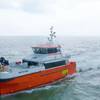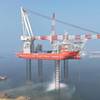Coast Guard Patrols with New RB-S II Vessel
Most people who encounter the Coast Guard near shore will get a good look at a Response Boat-Small (RB-S). With more than 400 boats in operation, the RB-S is the largest vessel class in the Coast Guard’s fleet. The boats are in constant use, from life-saving to law enforcement and homeland security missions. But the redoubtable RB-S is approaching the end of its service life and the the Coast Guard’s Acquisition Directorate has launched an ambitious project to replace this important asset. The RB-S II will be one of the largest boat buys of its kind. Already the service has accepted its first delivery order of 38 RB-S II boats.
The RB-S II is roughly three feet longer than the boat it is replacing: the 25-foot Defender-class RB-S, which was put into Coast Guard service in 2002. The RB-S II cabin is more open, giving the crew better visibility when searching their surroundings, and the boat’s electronics package and communications system have seen a significantly upgrade.
“The biggest reason for the replacement of the RB-S is electronic obsolescence, meaning if the radio breaks and we want to replace it, the manufacturer no longer makes those parts, so it becomes too costly to replace,” said Lt. Cmdr. Josh Fant, manager for the RB-S project.
The first RB-S II was delivered to the Coast Guard in June 2011 for testing and evaluation. The initial delivery order of 38 boats was completed in April. Boats have been delivered to the Coast Guard Special Mission Training Center aboard Marine Corps Base Camp Lejeune, Coast Guard Training Center Yorktown, Va., Sector Baltimore, Md., Sector New Orleans, Sector Los Angeles/Long Beach, Group Humboldt Bay, Calif., Group North Bend, Ore., Sector St. Petersburg, Fla., Sector San Juan, Puerto Rico, and Sector Southeast New England, Woods Hole, Mass. A second delivery order for 25 boats was placed in August 2012, which is expected to be complete by the end of the calendar year.
RB-S II in Action
As the RB-S II hits the front lines, it is receiving favorable reviews from the operators, for its improved capabilities and the human factors engineering aspects of its design.
“The consensus at the unit is that the RB-S II is a great platform for Station Humboldt Bay,” said Master Chief Jon Gagnon, officer in charge at Station Humboldt Bay. “We took the new boat out last week with a six-foot sea and she handled very well with the seas off the bow, stern and beam. The seats really do their job well and the boat handles great for our coxswains. We like the boat and look forward to having it at the unit.”
The new boats are already making a difference operationally as well. On the morning of Jan. 18, 2013, Sector Baltimore launched Station Oxford, Md.’s RB-S II to assist a vessel near the Chesapeake Bay that had lost its steering. As the winter weather got worse, the vessel in distress began to take on water over the bow and later over the sides of the boat. The RB-S II arrived on the scene and tow the vessel to safety in 15-knot wind and three-foot seas. Sector Baltimore kept in radio contact with the vessel in distress and a commercial fishing boat and Maryland Natural Resources Police boat assisted.
RB-S II Acquisition Strategy
The RB-S II project set out to find a replacement boat that was designed as a multi-mission asset, focusing on improving maintainability and crew comfort, which decreases fatigue during operations.
To select the new RB-S II design, the Coast Guard used a phased, competitive procurement, selecting two vendor designs to compete in a down select process. Each design was tested against Coast Guard requirements and industry’s ability to deliver the requirements at a reasonable cost was verified.
On Sept. 26, 2011, the Coast Guard awarded a delivery order, valued at approximately $13 million for the production of 38 RB-S II, to MetalShark Aluminum Boats of Jeanerette, La. The contract allows for the procurement of up to 500 boats through 2019. Up to 470 boats can be delivered to shore units throughout the Coast Guard to perform port and waterway security, search and rescue, drug and migrant interdiction, environmental and other law enforcement missions. As many as 20 boats may be ordered by Customs and Border Protection and up to 10 by the U.S. Navy.
The RB-S and RB-S II are some of the most versatile boats in the Coast Guard. They are used by the Service’s Deployable Operations Groups and can be deployed by air or ground vehicles to respond to emergencies, such as Hurricane Katrina and the Deepwater Horizon oil spill. The RB-S II cradled on a custom-made trailer recently conducted a fit-test for the HC-130J Long Range Surveillance Aircraft at Air Station Elizabeth City, N.C.
“We conducted a C-130 fit test at the acceptance of the prototype, back in July 2011, but the trailer has since been modified slightly, so we tested it again at Air Station Clearwater, Fla., in January, that was on the C-130H model, and then we did it on the C-130J model in early April in Elizabeth City,” Fant said. “Transportability in a CG C-130 was a requirement from the beginning, as we need to use organic assets to respond to a situation like Deepwater Horizon or Katrina, where you have to rapidly move boats. There are three more of these trailers being delivered in the next few months. We’re hoping to stage these trailers at all the C-130 air stations.”
The RB-S II is giving Coast Guard operators one of the most versatile, easily deployable assets in the fleet, with upgraded electronics and communication capabilities and improved crew comfort and endurance. Chances are, coastal and inland boaters will see one on patrol.
www.uscg.mil













